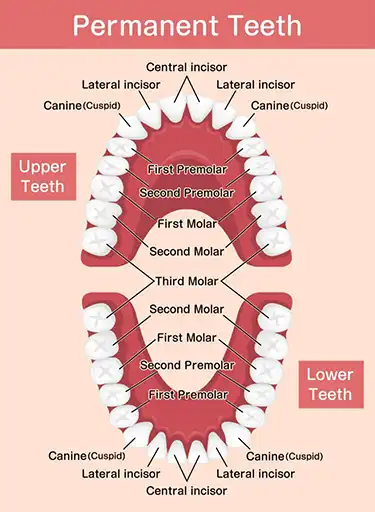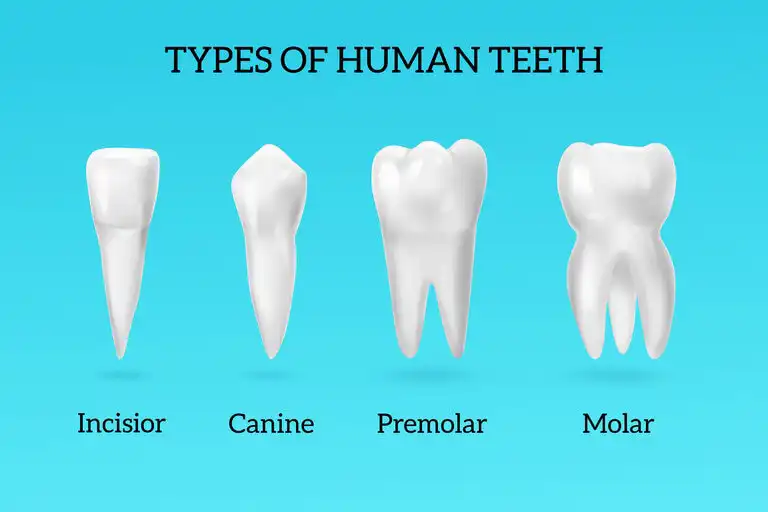
[ad_1]
Tooth like all elements of human physique have distinctive traits with every tooth carries its identify and performance. The construction of tooth is split into primarily arduous tissues and smooth tissue. Exhausting tissues embrace enamel, dentin and cementum (the calcified or mineralized connective tissue that covers the tooth’s roots and connects the tooth to the alveolar bone). Delicate tissue is the pulp, which has the function of offering each nerve and blood to the tooth. Let’s be taught extra about our various kinds of tooth and what they serve.
Major tooth and everlasting tooth
Tooth are advanced buildings and are growing by means of totally different ages and even earlier than the beginning in a person. The primary tooth that you simply see in a child’s mouth are referred to as major tooth or child tooth. That is when child teething stage has began the place most infants get their first tooth when they’re 6 months previous. Even within the utero, major tooth are in formation in 14 week of utero and this formation goes into a whole stage after beginning till three years of the infant’s age.

There’s one other stage of kids’s tooth phases that is known as blended dentition. It’s the time of the looks of the primary everlasting tooth that’s when youngsters are 6 years previous and the time of falling one by one of many major tooth.
The final stage of the tooth progress and eruption is known as the everlasting tooth interval. The everlasting tooth growth can prolong into 12 and 15 years of age to be in full formation. For the eruption of third molars in some folks we must always even wait to get to 25 years previous.
Variations between major and everlasting tooth
There are some variations between major and everlasting tooth aside from the time of eruption and durations of full formation.
- The pulp measurement in major tooth is bigger as we evaluate it with the dimensions of the crown.
- The lighter and whiter colour is a typical function of the infant tooth.
- The enamel and dentin which might be arduous tissue buildings of tooth are thinner than that of the everlasting tooth.
- Crown of tooth in child tooth is smaller.
- There are extra variations in roots and measurement of various tooth with tooth floor reminiscent of in major molar tooth.
The variety of tooth
If we divide the tooth by a symmetrical line, it’s cheap to divide them in each higher jaw (maxillary) and decrease jaw (mandibular) and begin with the median line, which is noticeable in most individuals. The median line separates the central incisors.
In all sides of this line, we’ve dental arch. In a traditional dental situation, there are 10 tooth in proper or left of the arch each in higher and decrease jaws in major tooth. So, in whole, there are 20 major tooth if no dental issues like trauma, lacking tooth (hypodontia), and different components exist.
The variety of everlasting tooth is 16 in all sides of the arch each higher and decrease tooth and in whole 32 everlasting tooth.
Kinds of tooth and their names
Tooth have names that we will name by. The names are related to the features that these tooth serve. There are three principal names: incisor, canine and molar. Premolar can also be the identify for added everlasting tooth that seem in everlasting tooth interval.

Incisors
These are the primary tooth you can see within the child tooth eruption phases, which have been utterly erupted by 16 months of child’s age. Incisors are the sequence of anterior tooth in entrance together with lateral and central tooth. These within the heart are referred to as central incisors and the subsequent to those centrals are referred to as lateral incisors.
There are 2 higher/decrease central incisors and a couple of higher/decrease lateral incisors in each major and everlasting tooth. In whole, there are eight incisors within the mouth. Because the identify suggests, these tooth have sharp incisors floor to operate as biting and reducing meals.
Canines
With the identify additionally exhibiting similarity, people have canine tooth much like what canines or different carnivorous animals have. There are four canine tooth within the higher and decrease arches. Canine tooth have pointed form or cusps and they’re longer than different tooth.
Canines are clear to see and spot. These are the third tooth from the median line within the symmetrical line we mentioned. From the beauty perspective, canines are actually essential tooth. The operate of the canine tooth can embrace meals tearing and stability of tooth within the mouth because of the distinctive place of the canines within the dental arch.
Premolars
There are four premolar tooth in higher jaw and four within the decrease jaw. In whole, there are eight premolars within the mouth. Premolars include first premolar (proper subsequent to canine tooth) and second premolar (proper in entrance of molar tooth).
Premolar tooth are between canines and molars. First premolar tooth assist canine in tearing the meals and are to some extent related in operate in that. Second premolars operate as grinding like molars however not with full grinding capabilities like molar tooth.
There aren’t any premolars within the major dentition they usually present up within the everlasting tooth, changing the molars in major dentition.
Molars
In case you look in the back of the mouth, you see the posterior tooth with many cusps (curves) on the floor of the tooth. Molar tooth are the biggest in dental arch. Each higher (maxillary) and decrease (mandibular) jaw have whole variety of 12 tooth, 6 higher and 6 decrease, three in both facet of the arch.
The operate of the molar tooth consists of a lot of the chewing course of (mastication) and making the meals into smaller items. Premolars have cusps to make the occlusion match and meals reducing and grinding simpler. There are primarily four or 5 cusps in a molar tooth, a key think about chewing work in addition to occlusion and the way tooth align.
Molar tooth include first molar (subsequent to second premolar), second molar, and knowledge tooth or third molar. Knowledge tooth are essentially the most posterior of the three and will not have sufficient room to develop usually in some folks.
[ad_2]